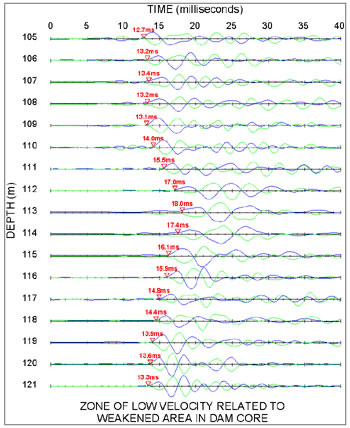The broad diversity of geological environments at proposed and existing dam sites presents unique challenges related to detailed geological mapping, seepage assessment, integrity evaluation, slope stability, foundation conditions and seismic hazard estimation. Geophysical methods provide direct answers and valuable additional data to augment other studies and more invasive means of evaluation such as drilling.
The seismic refraction method is the most frequently used geophysical means of investigating geological conditions at proposed damsites. Multichannel surveys on land or overwater produce detailed profiles of depths to bedrock, overburden layering and the competency or rippability of the bedrock. Shear or fault zones in the bedrock are often identified in seismic refraction investigations.
Seismic refraction surveying may be augmented in some instances by the seismic reflection, overwater acoustic profiling, ground penetrating radar or resistivity imaging methods. These surveys may be employed to provide more detailed geological layering information, geological information in areas of deep or fast moving water and the presence and configuration of karst conditions or voids in the abutments or foundation of the proposed structure.
A number of geophysical techniques are utilised to evaluate conditions at existing dam sites. Most of these methods find application on earth or rockfill structures with some methods also effective on concrete dams. The main applications of geophysical methods at existing dams are related to seepage assessment, integrity evaluations, foundation conditions and seismic hazard estimation. Anomalous seepage is most readily identified with the self or streaming-potential method. This technique utilises two potential electrodes to sense small voltage anomalies created by fluid flow, and the process of electrokinetic coupling. Potential differences can be measured above the flowpath either from the dam surface or from boreholes. Additional primary seepage assessment technologies are electrical resistivity imaging, Electromagnetic (EM) profiling and Ground Penetrating radar. Resistivity and Electromagnetic profiling surveys identify low resistivity anomalies consistent with active seepage paths. Ground Penetrating radar records can indicate zones of increased water content and solution cavities or fault zones in rock. Often, streaming potential surveys are implemented for monitoring purposes after remedial measures have been carried out to reduce seepage. 
Frequently, anomalous seepage results in sufficient internal erosion to affect the structural integrity of the dam. Severe erosion produces sinkholes within the dam and possibly on the reservoir floor. Effective techniques for locating sinkhole features within an earthen dam include resistivity imaging and streaming potential. Streaming potential surveys, augmented by high resolution sonar, can be effectively utilised in the reservoir area to find sinkholes.
Delineation of sinkholes within the dam is effectively carried out using downhole and crosshole seismic shear wave and shear wave tomography surveys. Downhole and crosshole shear wave surveying is very sensitive to void ratio due to loss of soil or fines which causes a reduction in effective stress. Detailed shear wave tomography surveying from boreholes can delineate the shape of sinkhole feature that are often larger than expected due to stress relief in the adjacent soils.
The evaluation of seismic hazard soil parameters and foundation conditions is generally carried out using the downhole and crosshole, compressional and shear wave methods. Earth material properties obtained from in situ measurements are utilised to predict ground accelerations due to earthquake loading. Layer seismic velocities are the key parameter in determining the dynamic response of a structure, as well as site liquefaction potential.
